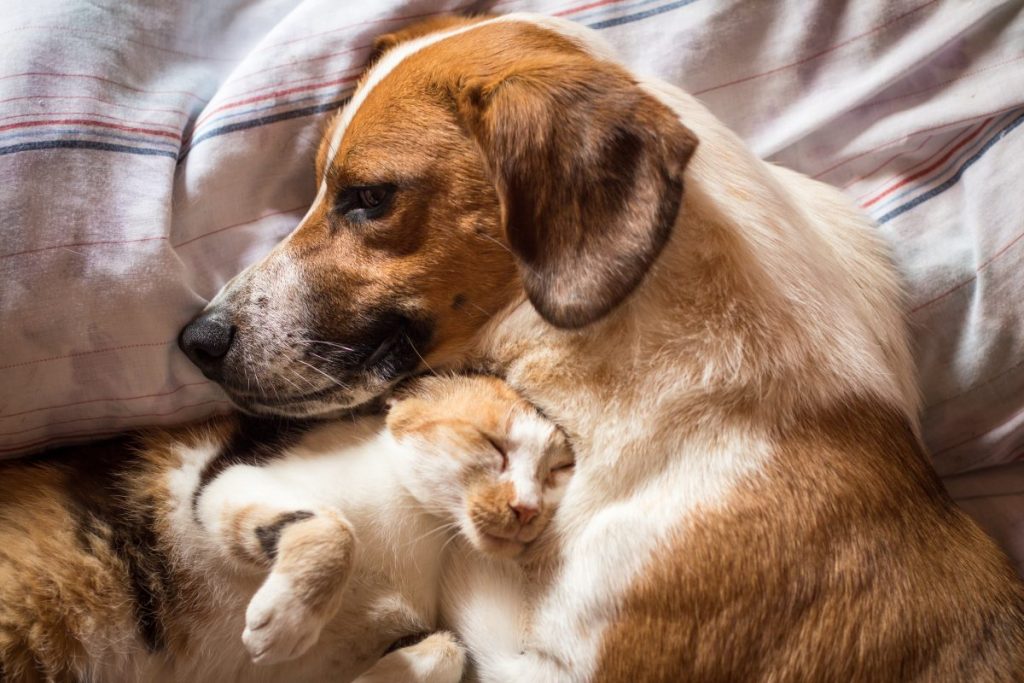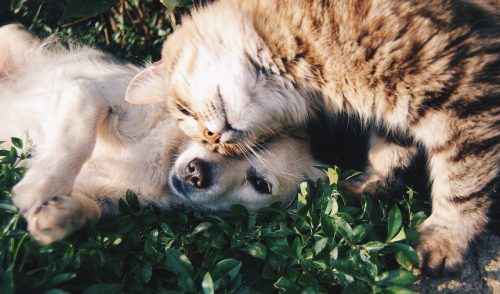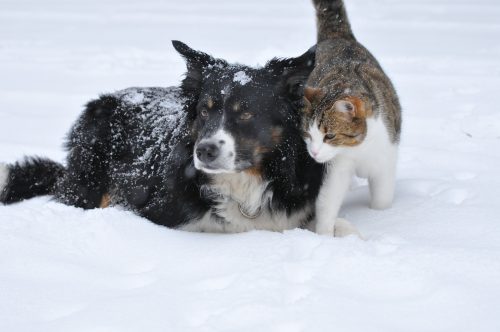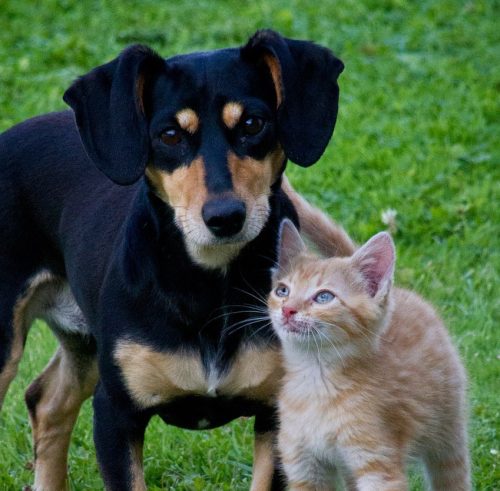Dogs versus cats—an age-old feud that people are all too familiar with. From classic cartoons to the common question: “are you a dog or a cat person?” there seems to be a misconception that dogs and cats cannot exist in the same a happy household.
But what if you do not want to be exclusively a dog person or a cat person? What if your heart is set on having both loveable creatures in your life? The good news is, dogs and cats are completely capable of getting along; however, there are a number of steps you should take to ensure a smooth transition into cohabitation.
Consider Your Pet’s Temperament
Before you get ahead of yourself and think about socialization, you should consider the pet you already have. If you already have a dog that is a major hunter who bolts off at the sign of a squirrel, a cat might not be the best match for this particular dog. You do not want to bring an animal into the house that your dog will consider prey.
While the biggest physical threat is typically dogs to cats, if you already have a cat, you should consider their temperament as well. If you have an aggressive cat that hisses and swats at new people and other animals, he or she may be extremely unhappy with another animal living in their space.
Although socialization is obtainable, you should still take the time to think about your pet’s personality and if another animal would be a good fit for them.
Factor in Your Pet’s Age & Activity Level
In addition to your pet’s temperament, you should also take their age and activity level into consideration. If you have an elderly dog or cat, getting a hyper and curious puppy or kitten may be off-putting to them.
Similarly, if your dog or cat is very energetic and you are getting a mellow creature, this may not be the best match. Essentially, you should try to match your dog or cat with another pet that you believe will mesh well with their existing habits and lifestyle.
See How the New Pet Interacts with Other Species
Before moving forward with the adoption or purchase of your new dog or cat, you can ask the adoption center if they have a dog or cat (whichever pet you already have at home) that you can introduce to your potential new pet. Seeing how the dog and cat get along in the adoption facility is a good indication of how the two species will interact at home.
Bringing your existing pet to the adoption center is not recommended because the new location, scents, sounds and abundance of other animals may be too overwhelming for them, which will not give you an accurate read on their reaction to the new animal.
Introduce Them Properly
Once you have determined if your dog or cat’s personality would work well with a newcomer, then you can move forward with bringing your newest furry family member into your home. One major mistake to avoid is letting your new pet loose with your old pet. This is a recipe for disaster and should definitely be avoided.
You often hear the expression that you never get a second chance to make a first impression, and the same can be said for the first introduction between your dog and cat. You should meticulously plan out the first meeting between your new and old pet in order to make things go as smoothly as possible.
If you are worried about introducing your dog and cat face to face, you can start with a more controlled method of easing the dog and cat into the same setting. Begin by creating a safe room for the dog and a separate room for the cat. Each room should have everything the dog or cat needs (food, water, litter box, bedding, toys, etc). When no one is home, each pet should be alone in his or her own room to avoid any fighting.
When you or someone is home to supervise, you should take turns letting one of the animals loose for a few hours, roaming the house as they normally would. As your new and old pet take turns exploring the house, their scent will be left behind for the next animal to discover when it is their turn to be out. By practicing this rotation method for a couple of days, your animals should become accustom to the scent of each other.
You can also switch some of the bedding back and forth between the two rooms so that the dog and cat are further exposed to the scent of one another. During this time of separation, if your dog acts particularly aggressive or interested in the cat’s room (digging at the door or being completely fixated on the door) this may indicate that he or she is trying to hunt the cat.
This means that the dog is not ready to meet the cat, and you should stretch out the separation period a bit longer. If this behavior persists, you may need a professional to help socialize the two animals; however, the hope is that the animals will become desensitized to each other over time with exposure.
After a few days of keeping your dog and cat separated and they both seem calm, you can try a face-to-face introduction. You will know your pets are ready for this step once they are back to their usual behaviors such as eating and sleeping regularly instead of being distracted and obsessed with the presence of the other animal.
During this first meeting, your dog should be on a leash and your cat can be loose. This is because in the vast majority of dog versus cat rivalries, the dog is the hunter and the cat is they prey. Bring the animals into a common space and slowly introduce the two while keeping your dog on his or her leash.
During this meeting, you can observe the body language of both your dog and cat to assess their comfort levels. This will help you determine whether they are okay to be alone together or if you need to go back to the separation step.
What Should You Look for When Introducing Your Dog & Cat?
In regards to body language, you should be on the lookout for signs of fear and aggression. If your cat’s hair is raised, ears are back, tail is swishing back and forth and they are hissing, he is indicating that he is not comfortable around the dog. On the other hand, if your cat seems calm and is sniffing your dog, this is a sign that your dog and cat will soon be able to coexist.
When observing your dog, you should be on the lookout for hunting behaviors. If your dog seems fixated on the cat such as keeping his or her eyes locked on the cat and ignoring you, they are not ready to be alone with the cat. If your dog is exhibiting these behaviors, make sure you have a good handle on the leash because he or she may lunge at the cat.
If your dog is focused on the cat and will not stop, it is best to separate them and try again at a later time. Conversely, when you introduce your dog and cat, if you command your dog to sit and he or she listens to you while the cat roams the room, this is a great sign. Reward your dog with treats if they are sitting and listening to you instead of attempting to hunt your feline friend.
Even if your dog and cat do not display signs of aggression after the first meeting, you should still separate them by keeping them in their appropriate rooms awhile longer. During this period, you should do a few more on-leash meetings to ensure you are confident in your dog and cat’s abilities to behave around one another.
If your dog and cat are showing signs of fear and aggression, you should go back to phase one for a while before trying a face-to-face introduction again. The more supervised socialization the better.
Long-Term Socialization Tips for Multi-Pet Households
If your dog is not acclimating to the cat, you can try distracting your dog in order to teach him or her not to be so fixated on the cat. Begin by figuring out how close your dog can be to your cat without lunging and barking. This will be different for every dog and may be as close as five feet or as far away as twenty feet.
Once you have determined how far your dog needs to be without lunging, sit down with a handful of small treats or kibble. At this point, your dog will probably be staring at the cat. Break your dog’s concentration by calling his or her name or giving a command to look at you.
When you get your dog to look at you, give them a treat. After the treat, your dog is likely to stare at the cat again. Repeat the process of giving a treat when your dog breaks their fixation on the cat and looks at you ten times.
Once your dog learns to look at you before getting a treat, move a few feet closer to the cat. This process may take awhile, but the hope is that your dog will understand that they are being rewarded for ignoring the cat, aiding in the desensitization.
Whether your dog and cat immediately seem comfortable around one another on the leash or it takes months of practice, you will eventually be ready for off-leash encounters. During these off-leash meetings, someone should always be supervising. Even if your animals seem fine, you should separate them when you have to leave the house.
After about a month of successful supervised socialization meetings, your dog and cat are ready to be left alone in each other’s company. Only move to this phase of socialization if you are completely confident that your dog and cat will not injure one another. If you have only been socializing your pets inside the house, they may act differently in the yard once they start running around.
If you plan on leaving them alone in a variety of settings, ensure that during your month of supervised encounters, you carefully watch them both inside the house and in the yard. This ensures your pets are comfortable in both settings before trusting them to be alone.
If the socialization process simply does not seem to be working for one of your pets, do not scold or punish them. One must remember that although we love our pets like family, they are animals with certain instincts and should not be reprimanded for behaving that way.
Instead of scolding, always try to praise and reward your dog or cat for good, calm behaviors instead of punishing them for displaying fear or aggression. If you have tirelessly tried socializing your dog and cat and they refuse to get along, you have a few options.
One option is not to keep your new pet. This is a very difficult and sad decision to make, which is why it is recommended to thoroughly consider your original pet’s personality before making the decision to add another member to the family. This is another reason it is important to ask the adoption agency or breeder if you can see how the dog or cat interacts with a member of the other species before making the commitment to bringing your new pet home.
As unfortunate as it is, your dog or cat simply may not be able to cohabitate with the other animal. In this case you could try pairing a dog with a dog or a cat with a cat. Since this is not the ideal situation, there are also trained professionals that can work on socializing your dog and cat. Although this will take additional time and funds, it may be worth it so that you do not have to be only a “dog person” or a “cat person.”
Socializing a dog and cat can be a lengthy process, but once you break through, your efforts will be well worth the wait. Some dogs and cats will get along right off the bat, and others will take more time with supervised socialization and training. Regardless of the initial reaction, socialization is possible. By approaching the socialization of your dog and cat in a manner that takes both animals into consideration, you are more likely to achieve success.








